Black tourism, also known as dark tourism, involves traveling to sites associated with death, tragedy, and suffering. This type of tourism offers a unique way to learn about challenging historical events and honor the victims. SIXT.VN provides seamless travel experiences, ensuring a respectful and informative journey. You can explore poignant sites, engage with the past, and gain a deeper understanding of resilience and remembrance. Consider your options of grief tourism and heritage tourism for educational journeys.
1. Understanding What Black Tourism Truly Is
Black tourism, a niche within the broader tourism industry, involves visiting sites associated with death, disaster, suffering, or the macabre. While it might sound morbid, black tourism offers unique educational and introspective opportunities. It allows individuals to connect with history, learn about tragic events, and honor the victims of these events. Black tourism also provides economic benefits for communities surrounding these sites, helping to preserve and maintain them for future generations. It encourages empathy, understanding, and remembrance.
1.1. Defining the Core Elements of Black Tourism
Black tourism centers on sites that hold significant historical or contemporary relevance due to associations with death, suffering, and tragedy. Unlike traditional tourism, which often focuses on leisure and entertainment, black tourism delves into somber aspects of human history. These sites include battlefields, concentration camps, memorial sites, and disaster zones. Key elements of black tourism include:
- Sites of Death: Locations where large-scale deaths occurred due to conflict, disaster, or genocide.
- Sites of Suffering: Places associated with oppression, injustice, and human rights violations.
- Memorials and Museums: Institutions dedicated to preserving and presenting the history of tragic events.
- Disaster Zones: Areas impacted by natural or man-made disasters, often visited to understand the event’s impact and honor the victims.
1.2. Disentangling Black Tourism from Similar Concepts
While black tourism may overlap with other forms of tourism, it is essential to differentiate it. Concepts such as heritage tourism, thanatourism, and grief tourism share characteristics with black tourism but have distinct focuses.
- Heritage Tourism: Focuses on cultural and historical sites, not necessarily linked to death or tragedy.
- Thanatourism: A broader term encompassing any tourism related to death, including cemeteries and funerary rituals.
- Grief Tourism: Involves traveling to sites specifically to mourn or grieve, often personal or collective.
Black tourism distinguishes itself by its emphasis on learning and reflection about significant tragic events rather than mere morbid curiosity or personal mourning. This distinction shapes the motivations of black tourists and the responsibilities of site managers.
2. Motivations Behind Engaging in Black Tourism
Understanding why people choose to engage in black tourism reveals profound insights into human nature and the quest for knowledge and connection. Several factors drive individuals to visit sites of death and tragedy.
2.1. Educational Curiosity and Historical Awareness
Many individuals are drawn to black tourism sites out of a desire to learn more about historical events. Museums, memorial sites, and former concentration camps serve as powerful educational resources, providing detailed accounts and artifacts that bring history to life. According to research from the Journal of Tourism Management, in 2020, educational motivations are significant drivers for individuals participating in dark tourism.
2.2. Empathy and Connection to Human Suffering
Visiting sites of tragedy can evoke strong feelings of empathy, enabling visitors to connect with the suffering of others on a deeply personal level. These experiences can foster a sense of shared humanity and encourage reflection on the importance of compassion and understanding.
2.3. Remembrance and Honoring Victims
Black tourism offers a way to pay respects to victims of tragic events. Memorial sites and monuments provide a space for visitors to honor the deceased, ensuring that their stories are not forgotten. This act of remembrance can be a powerful form of collective mourning and a means of affirming the value of human life.
2.4. Existential Reflection and Personal Growth
Engaging with themes of death and tragedy can prompt deep existential reflection, leading to personal growth and a renewed appreciation for life. Confronting the darker aspects of human history can encourage individuals to re-evaluate their values and priorities, fostering resilience and a greater sense of purpose.
3. Examples of Prominent Black Tourism Destinations Worldwide
Numerous sites around the world attract black tourists, each offering unique insights into historical events and human experiences.
3.1. Auschwitz-Birkenau Memorial and Museum (Poland)
Auschwitz-Birkenau stands as the most infamous symbol of the Holocaust, where approximately 1.1 million people, mostly Jews, were murdered during World War II. The site includes the preserved remains of gas chambers, crematoria, barracks, and personal belongings of the victims.
- Educational Tours: Guided tours provide historical context and personal stories.
- Memorial Services: Commemorative events honor the victims and promote remembrance.
- Preservation Efforts: Ongoing efforts to maintain the site and artifacts for future generations.
3.2. Ground Zero/9/11 Memorial & Museum (USA)
The 9/11 Memorial & Museum in New York City commemorates the victims of the September 11, 2001 attacks. The memorial features twin reflecting pools set in the footprints of the former World Trade Center towers, while the museum showcases artifacts, personal stories, and historical accounts of the events.
- Reflecting Pools: Symbolic representation of loss and remembrance.
- Historical Exhibits: Comprehensive displays detail the events leading up to and following the attacks.
- Educational Programs: Initiatives designed to educate visitors about the impact of terrorism and the importance of unity.
3.3. Hiroshima Peace Memorial Park (Japan)
The Hiroshima Peace Memorial Park is dedicated to the victims of the atomic bombing on August 6, 1945. The park includes the iconic Atomic Bomb Dome, a preserved ruin of a building that survived the blast, as well as museums, monuments, and gardens that promote peace and reconciliation.
- Atomic Bomb Dome: A haunting reminder of the destructive power of nuclear weapons.
- Peace Memorial Museum: Exhibits detailing the events of the bombing and its aftermath.
- Annual Ceremonies: Commemorative events promoting peace and nuclear disarmament.
3.4. Tuol Sleng Genocide Museum and Choeung Ek Memorial (Cambodia)
Tuol Sleng Genocide Museum, a former high school turned prison by the Khmer Rouge regime, serves as a chilling reminder of the Cambodian genocide. Choeung Ek Memorial, also known as the Killing Fields, is a mass grave site where thousands of prisoners were executed.
- Tuol Sleng Museum: Preserved prison cells and torture devices.
- Choeung Ek Memorial: Mass graves marked with a memorial stupa.
- Survivor Testimonials: Personal accounts providing insights into the atrocities committed.
4. Ethical Considerations and Responsible Practices in Black Tourism
Engaging in black tourism requires a high degree of sensitivity and respect. It is crucial to approach these sites with an understanding of the profound human suffering they represent and to avoid perpetuating harm or disrespect.
4.1. Respecting the Dignity of Victims and Survivors
The foremost ethical consideration in black tourism is respecting the dignity of victims and survivors. This involves refraining from sensationalizing or trivializing tragic events and ensuring that narratives are presented with accuracy and empathy. According to research from the International Journal of Heritage Studies, responsible tourism ensures that the voices of victims and survivors are prioritized.
4.2. Avoiding Sensationalism and Exploitation
Black tourism sites should not be treated as mere spectacles or entertainment venues. Site managers and tour operators have a responsibility to avoid sensationalism and exploitation, focusing instead on education, remembrance, and reflection.
4.3. Supporting Local Communities and Economies
Black tourism can provide economic benefits for communities surrounding these sites. It is essential to ensure that these benefits are distributed equitably, supporting local businesses and initiatives that contribute to the preservation and interpretation of historical events.
4.4. Balancing Education with Sensitivity
While education is a primary goal of black tourism, it is crucial to strike a balance between providing information and maintaining sensitivity. Information should be presented in a way that is informative and respectful, avoiding graphic or gratuitous details that could cause distress.
5. The Role of Technology in Enhancing Black Tourism Experiences
Technology plays an increasingly important role in enhancing black tourism experiences, offering new ways to engage with history and connect with these sites.
5.1. Virtual Reality and Augmented Reality Tours
Virtual reality (VR) and augmented reality (AR) technologies can provide immersive and educational experiences, allowing visitors to explore historical sites in a more interactive way. VR tours can recreate historical events and environments, while AR apps can overlay additional information and insights onto physical sites.
5.2. Interactive Exhibits and Digital Storytelling
Interactive exhibits and digital storytelling techniques can enhance visitor engagement and understanding. Touchscreen displays, multimedia presentations, and digital archives can provide access to a wealth of information and personal stories, creating a more dynamic and compelling learning environment.
5.3. Online Resources and Educational Platforms
Online resources and educational platforms extend the reach of black tourism sites, providing access to information and resources for individuals who may not be able to visit in person. Online archives, virtual tours, and educational programs can promote greater awareness and understanding of tragic events.
5.4. Mobile Apps for Guided Tours and Information Access
Mobile apps offer convenient access to guided tours, historical information, and practical details for visitors. GPS-enabled apps can provide location-based information and personalized recommendations, enhancing the overall visitor experience.
6. Cultural Significance and Global Perspectives on Black Tourism
Black tourism is shaped by cultural attitudes, historical contexts, and global perspectives. Understanding these influences is crucial for interpreting the significance of black tourism sites and promoting responsible engagement.
6.1. Varying Cultural Attitudes Towards Death and Tragedy
Cultural attitudes towards death and tragedy vary widely around the world, influencing how black tourism sites are interpreted and experienced. Some cultures may emphasize mourning and remembrance, while others may focus on resilience and healing.
6.2. The Impact of Historical Context on Site Interpretation
Historical context plays a critical role in shaping the interpretation of black tourism sites. Understanding the political, social, and economic factors that contributed to tragic events is essential for providing accurate and nuanced accounts.
6.3. Global Perspectives on Remembrance and Reconciliation
Global perspectives on remembrance and reconciliation influence how black tourism sites are managed and interpreted. Some sites may focus on promoting healing and forgiveness, while others may emphasize accountability and justice.
6.4. The Role of Black Tourism in Fostering Dialogue and Understanding
Black tourism can serve as a catalyst for fostering dialogue and understanding between different cultures and communities. By providing a space for reflection and engagement, these sites can promote greater empathy and encourage collective efforts to prevent future tragedies.
7. Case Studies: Examining Specific Black Tourism Sites in Detail
Examining specific black tourism sites in detail provides valuable insights into the challenges and opportunities associated with this type of tourism.
7.1. Robben Island (South Africa): A Symbol of Resistance Against Apartheid
Robben Island, a former prison off the coast of Cape Town, symbolizes the struggle against apartheid in South Africa. Nelson Mandela and other political prisoners were incarcerated on the island for many years, enduring harsh conditions and racial discrimination. Today, Robben Island serves as a museum and UNESCO World Heritage Site, offering guided tours led by former prisoners who share their personal experiences and insights.
- Guided Tours Led by Former Prisoners: Providing firsthand accounts and historical context.
- Preservation of Prison Cells and Artifacts: Maintaining the authenticity of the site.
- Educational Programs on Apartheid History: Promoting awareness and understanding of the struggle against racial segregation.
7.2. Chernobyl Exclusion Zone (Ukraine): A Site of Nuclear Disaster
The Chernobyl Exclusion Zone, an area surrounding the site of the 1986 Chernobyl nuclear disaster, attracts visitors interested in understanding the impact of nuclear accidents and the long-term effects on the environment and human health. Tours of the exclusion zone provide a glimpse into the abandoned towns and villages, as well as the ongoing efforts to contain the radiation.
- Guided Tours of Abandoned Towns and Villages: Providing insights into the lives of former residents.
- Visits to the Chernobyl Nuclear Power Plant: Exploring the site of the disaster and the ongoing containment efforts.
- Scientific Research and Environmental Monitoring: Studying the long-term effects of radiation on the environment.
7.3. Srebrenica Memorial Center (Bosnia and Herzegovina): Commemorating Genocide Victims
The Srebrenica Memorial Center commemorates the victims of the 1995 Srebrenica genocide, where over 8,000 Bosnian Muslim men and boys were systematically murdered by Bosnian Serb forces. The memorial center includes a museum, a cemetery, and educational programs that promote remembrance and reconciliation.
- Museum Exhibits on the Srebrenica Genocide: Providing historical context and personal accounts of the victims.
- Annual Commemorative Events: Honoring the victims and promoting reconciliation.
- Educational Programs on Conflict Prevention: Encouraging dialogue and understanding between different ethnic groups.
7.4. Nanjing Massacre Memorial Hall (China): Remembering Victims of Japanese Atrocities
The Nanjing Massacre Memorial Hall commemorates the victims of the Nanjing Massacre, also known as the Rape of Nanjing, which occurred in 1937 during the Second Sino-Japanese War. The memorial hall features exhibits, sculptures, and historical documents that detail the atrocities committed by Japanese soldiers against Chinese civilians.
- Exhibits Detailing the Atrocities of the Nanjing Massacre: Providing a comprehensive historical account.
- Sculptures and Monuments Honoring the Victims: Serving as a space for remembrance and reflection.
- Educational Programs on Sino-Japanese Relations: Promoting greater understanding and reconciliation between China and Japan.
8. The Economic Impact of Black Tourism on Local Communities
Black tourism can have a significant economic impact on local communities, providing income, employment, and investment opportunities.
8.1. Generating Revenue Through Tourism-Related Services
Black tourism sites often generate revenue through entrance fees, guided tours, souvenir sales, and other tourism-related services. This revenue can be used to support the preservation and maintenance of these sites, as well as to fund local community initiatives. According to research from the Journal of Sustainable Tourism, in 2018, tourism-related services provide essential income for communities.
8.2. Creating Employment Opportunities for Local Residents
Black tourism sites can create employment opportunities for local residents in areas such as guiding, hospitality, and site management. These jobs can provide a much-needed source of income and help to improve the economic well-being of the community.
8.3. Supporting Local Businesses and Infrastructure Development
Black tourism can support local businesses such as hotels, restaurants, and shops, as well as stimulate investment in infrastructure development. This can lead to improved living conditions and greater economic opportunities for local residents.
8.4. Balancing Economic Benefits with Site Preservation
While black tourism can provide economic benefits, it is crucial to balance these benefits with the need to preserve the integrity and authenticity of these sites. Sustainable tourism practices should be implemented to minimize the negative impacts of tourism on the environment and cultural heritage.
9. The Future of Black Tourism: Trends and Challenges
The future of black tourism is shaped by emerging trends, technological advancements, and evolving ethical considerations.
9.1. Increased Interest in Dark History and Heritage
There is a growing global interest in dark history and heritage, driven by a desire to learn more about tragic events and to connect with the past in a meaningful way. This trend is expected to fuel the growth of black tourism in the coming years.
9.2. The Impact of Social Media and Online Reviews
Social media and online reviews play an increasingly important role in shaping tourist perceptions and decisions. Positive reviews and compelling online content can attract more visitors to black tourism sites, while negative reviews can deter potential tourists.
9.3. Addressing Over-Tourism and Site Degradation
Over-tourism can pose a significant challenge to black tourism sites, leading to overcrowding, environmental degradation, and a diminished visitor experience. Sustainable tourism practices, such as limiting visitor numbers and implementing responsible site management policies, are essential for addressing this issue.
9.4. The Evolving Role of Technology in Shaping Visitor Experiences
Technology is expected to play an even greater role in shaping visitor experiences at black tourism sites in the future. Virtual reality, augmented reality, and artificial intelligence can provide new ways to engage with history, learn about tragic events, and connect with other visitors.
10. Planning Your Black Tourism Trip with SIXT.VN: Services and Support
Planning a black tourism trip requires careful consideration and attention to detail. SIXT.VN offers a range of services and support to ensure a seamless, respectful, and informative journey.
10.1. Comprehensive Travel Consultation Services
SIXT.VN provides comprehensive travel consultation services to help you plan your black tourism trip. Our experienced travel experts can provide insights into the historical context of various sites, recommend responsible tour operators, and assist with itinerary planning.
10.2. Convenient Airport Transfer Services
Arrive in Vietnam stress-free with SIXT.VN’s convenient airport transfer services. Our professional drivers ensure a safe and comfortable journey from the airport to your hotel, allowing you to focus on your upcoming exploration.
10.3. Wide Range of Hotel Booking Options
SIXT.VN offers a wide range of hotel booking options to suit your budget and preferences. Whether you prefer a luxury hotel or a budget-friendly guesthouse, we can help you find the perfect accommodation for your black tourism trip.
10.4. Guided Tours to Historical and Memorial Sites in Hanoi
Explore Hanoi’s historical and memorial sites with SIXT.VN’s guided tours. Our knowledgeable guides provide in-depth insights into the events and people that have shaped Vietnam’s history, ensuring a respectful and educational experience.
Table: Popular Historical and Memorial Sites in Hanoi
| Site | Description |
|---|---|
| Ho Chi Minh Mausoleum | Final resting place of Ho Chi Minh, Vietnam’s first president. |
| Hoa Lo Prison (Hanoi Hilton) | Former prison used by French colonists and later by North Vietnam during the Vietnam War. |
| Temple of Literature | Vietnam’s first university, dedicated to Confucius. |
| War Remnants Museum | Showcases artifacts and exhibits related to the Vietnam War. |
| Imperial Citadel of Thang Long | A UNESCO World Heritage Site, representing centuries of Vietnamese history and culture. |
10.5. Flight Booking Assistance for International Travelers
SIXT.VN offers flight booking assistance for international travelers, helping you find the best deals and convenient flight schedules for your trip to Vietnam.
10.6. Hanoi Tour Packages Tailored to Your Interests
Discover Hanoi’s rich history and cultural heritage with SIXT.VN’s tailored tour packages. Whether you are interested in exploring historical sites, museums, or cultural attractions, we can create a tour package that meets your specific interests and preferences.
Table: Sample Hanoi Tour Packages
| Package Name | Description | Price (USD) |
|---|---|---|
| Hanoi Historical Sites Tour | Explore Ho Chi Minh Mausoleum, Hoa Lo Prison, and the Temple of Literature with a knowledgeable guide. | 99 |
| Hanoi Cultural Immersion Tour | Visit local markets, traditional villages, and attend a water puppet show for an authentic cultural experience. | 129 |
| Hanoi City Highlights Tour | Discover the best of Hanoi, including the Old Quarter, Hoan Kiem Lake, and the War Remnants Museum. | 149 |
Act Now: Contact SIXT.VN today to book your Hanoi tour package and embark on a memorable journey of discovery.
SIXT.VN is committed to providing exceptional service and support for your black tourism trip to Vietnam. Contact us today to start planning your journey.
Address: 260 Cau Giay, Hanoi, Vietnam
Hotline/Whatsapp: +84 986 244 358
Website: SIXT.VN
Conclusion
Black tourism offers a unique opportunity to learn about tragic events, connect with history, and honor the victims of human suffering. By approaching these sites with respect, sensitivity, and a commitment to responsible practices, you can engage in a meaningful and transformative travel experience. Let SIXT.VN guide you through Vietnam’s poignant historical sites, providing seamless and respectful travel experiences. Explore the past, remember the victims, and promote a future of peace and understanding with SIXT.VN. Choose your ethical travel and commemorative trips with assurance.
FAQ: Understanding Black Tourism
1. What exactly is black tourism?
Black tourism, also known as dark tourism, involves traveling to sites associated with death, tragedy, suffering, or the macabre. It provides educational and introspective opportunities, allowing individuals to connect with history and honor victims.
2. Why do people engage in black tourism?
People engage in black tourism for various reasons, including educational curiosity, a desire to connect with human suffering, a need to remember and honor victims, and to promote existential reflection and personal growth.
3. What are some examples of black tourism destinations?
Some prominent examples of black tourism destinations include Auschwitz-Birkenau Memorial and Museum (Poland), Ground Zero/9/11 Memorial & Museum (USA), Hiroshima Peace Memorial Park (Japan), and Tuol Sleng Genocide Museum and Choeung Ek Memorial (Cambodia).
4. How can black tourism be conducted ethically?
Conducting black tourism ethically involves respecting the dignity of victims and survivors, avoiding sensationalism and exploitation, supporting local communities and economies, and balancing education with sensitivity.
5. What is the difference between black tourism and heritage tourism?
Heritage tourism focuses on cultural and historical sites, not necessarily linked to death or tragedy, whereas black tourism specifically involves sites associated with death, disaster, and suffering.
6. How does technology enhance black tourism experiences?
Technology enhances black tourism experiences through virtual reality tours, interactive exhibits, online resources, and mobile apps for guided tours and information access.
7. What are the economic benefits of black tourism?
Black tourism can generate revenue through tourism-related services, create employment opportunities for local residents, and support local businesses and infrastructure development.
8. What are the challenges associated with black tourism?
Challenges associated with black tourism include the risk of sensationalism and exploitation, respecting the dignity of victims and survivors, and addressing over-tourism and site degradation.
9. How does cultural context influence black tourism?
Cultural attitudes towards death and tragedy, historical context, and global perspectives on remembrance and reconciliation all influence how black tourism sites are interpreted and experienced.
10. How can SIXT.VN assist with planning a black tourism trip to Vietnam?
SIXT.VN provides comprehensive travel consultation services, convenient airport transfer services, a wide range of hotel booking options, and guided tours to historical and memorial sites in Hanoi, tailored to your interests.
{width=639 height=935}
alt: The image displays hikers exploring the diverse terrain of Badlands National Park, featuring a vast, sun-drenched landscape with unique rock formations under a clear sky, which promotes the park as a prime dark tourism destination.
{width=599 height=601}alt: The image captures Mount Rushmore, showcasing the carved faces of four prominent U.S. presidents, set against a bright blue sky, representing a powerful memorial site and a dark tourism attraction.
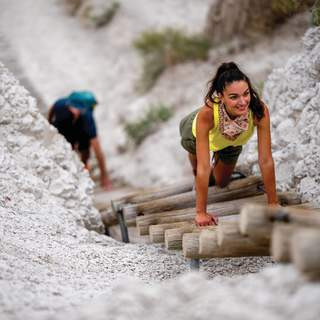 Things To Do
Things To Do
*alt:* The photograph showcases the rugged landscapes of the Badlands, providing an opportunity for dark tourism, and with unique geological formations, captured during the sunset, inviting visitors to explore nature.* Places To Stay
Places To Stay
*alt:* The image presents a cozy, rustic cabin nestled amid lush trees, providing lodging for dark tourists, symbolizing comfort and isolation and a unique setting for reflection.*{width=320 height=320}alt: The photograph showcases an array of food items, featuring local cuisine, and drink selections, presenting dining experiences for dark tourists, inviting visitors to enjoy regional specialties.
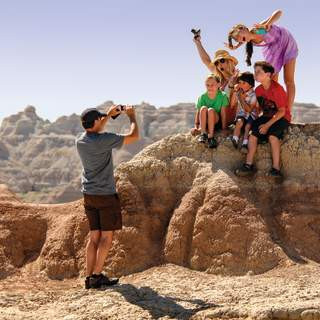 Badlands National Park Hiking
Badlands National Park Hiking
*alt:* A wide view of hiking trails within Badlands National Park, showing the harsh yet beautiful landscape, demonstrating adventure and natural discovery within a dark tourism destination. {width=560 height=373} alt: Serene Pactola Lake, framed by dense forest, giving chances for dark tourism and reflection near the natural scene.
 Kadoka Buffalo Stampede
Kadoka Buffalo Stampede
*alt:* Image of a lively ranch rodeo, featuring the Kadoka Buffalo Stampede, showing regional culture, as well as entertainment for the dark tourism travelers. 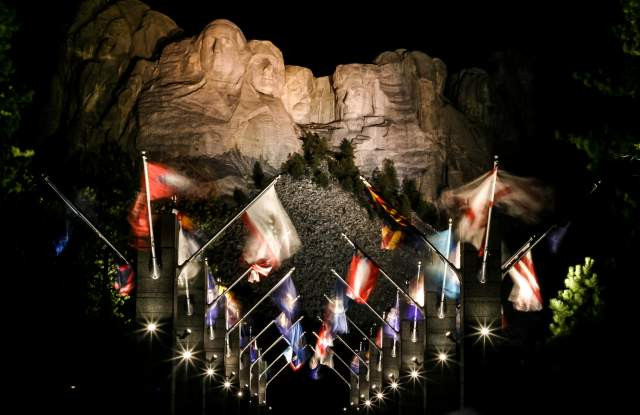{width=640 height=415} alt: The Mount Rushmore monument lit at night, during the evening lighting ceremony, is an aesthetic spectacle for the ones in search of grief tourism.
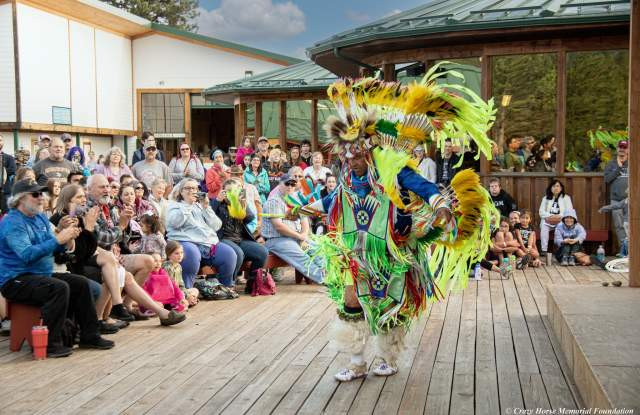 Native American Performers and Storytellers at Crazy Horse Memorial®
Native American Performers and Storytellers at Crazy Horse Memorial®
*alt:* The image shows the event of local Native American performers and storytellers at the Crazy Horse Memorial, as a memorial event for the dark tourism and grief tourism. {width=640 height=415} alt: Capture of participants running the Deadwood Mickelson Trail Marathon, promoting fitness and trail events that might be of a dark tourists’ interest.
[  Frühlingsfest at Main Street Square
Frühlingsfest at Main Street Square
*alt:* People enjoying a vibrant Frühlingsfest at Main Street Square, giving cultural opportunities and festive environment, for dark tourism too. {width=640 height=415} alt: Image of a live concert from Hart Ranch Summer Music Series, displaying local arts, as well as community activities, adding local charm to the dark tourism.
[ 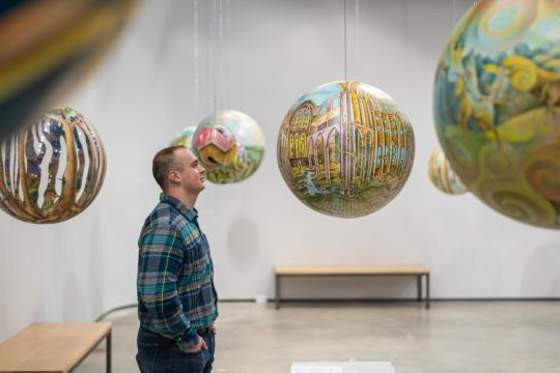 Top Spots to Find Local Black Hills Art in Downtown Rapid City
Top Spots to Find Local Black Hills Art in Downtown Rapid City
*alt:* The photograph presents a shot inside the Dahl Arts Center during the Termesphere exhibit, in order to emphasize local art as another facet of destination highlights for grief tourism. [ 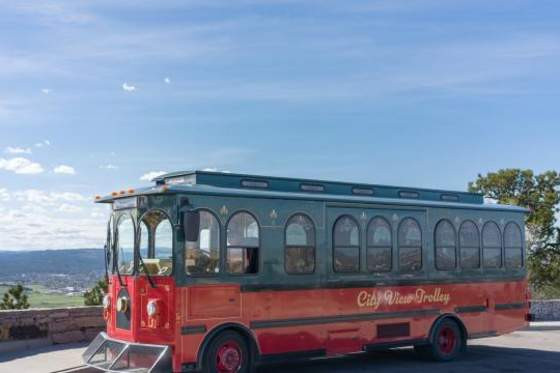{width=560 height=373} alt: The visual showcases an urban view from a trolley, giving transportation services for exploring downtown, for heritage tourism and dark tourism.
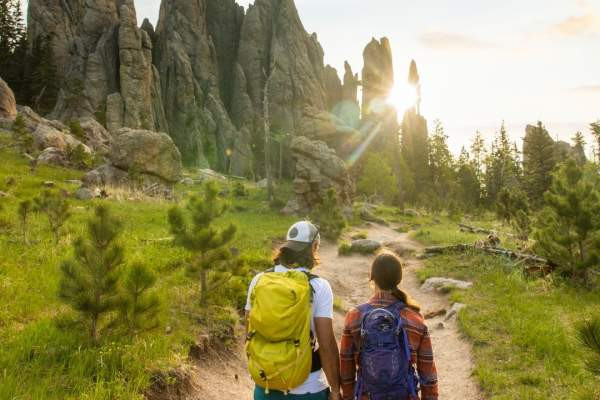 Hiking
Hiking
*alt:* The photo exhibits hiking options for the tourists, presenting adventures in the region. {width=600 height=400}alt: Photo of rock climbing on the destination for black tourism, where extreme sports opportunities and activities are shown.
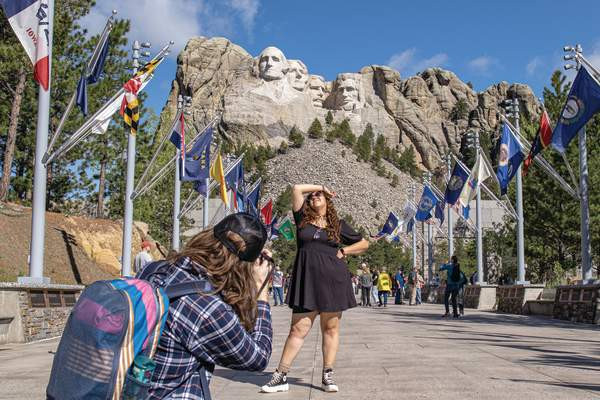 Mount Rushmore National Memorial
Mount Rushmore National Memorial
*alt:* A well shot iconic landmark of Mount Rushmore in the U.S., showing faces for dark tourism, where monuments are explored.


